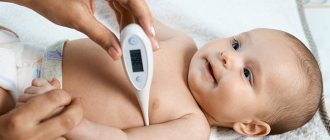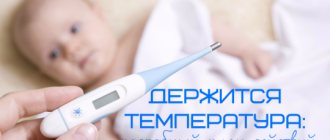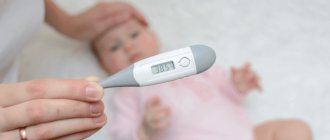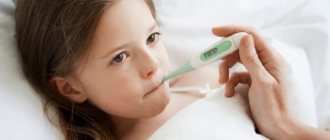Temperature norm
Many continue to believe that the temperature norm for any healthy person and child is 36.6 degrees. But in fact, this indicator is as individual as everything else in the human body.
For babies under 1-2 years old, body temperature can constantly change, ranging from 36.0 to 37.5 degrees, while the child will feel completely healthy. The reason is the imperfection of thermoregulation of a small organism. Therefore, in this case, before sounding the alarm, you should make sure that the child is not cold, thirsty or stuffy.
For older children, a temperature of 37.0 degrees can also be its own variant of the norm if it occurs quite often and is not accompanied by anything else. In any case, without consulting a doctor, you should not judge the options for normality or anomaly in this case.
When 37.1 is an alarm
Prolonged low-grade fever is not a very good condition. The positive effect of increasing temperature at 37.1, as at 38-39℃, does not appear. But the protective forces of the immune system are undermined due to increased evaporation of water from the skin and dehydration gradually increases. 37.1 in this case is not the worst option, because it is on the border of the norm.
What can such a slight increase indicate if it is accompanied by weakness, lethargy, moodiness, but no other symptoms? About the presence of a hidden, sluggish process:
- infectious, including a weak reaction to vaccination;
- mildly traumatic, which includes teething;
- allergic;
- autoimmune;
- tumor.
If there are no painful symptoms and your nerves are strong, you can take a wait-and-see approach. Without forgetting:
- prevent dehydration by drinking plenty of fluids,
- carefully monitor the child’s condition;
- Measure your temperature three times a day.
If it does not normalize on its own, the cause must appear.
At the first warning sign, when you seek medical help immediately, you will already have the information to make the correct diagnosis. Symptoms at 37.1 in a child and their possible causes
| Sign | Diseases |
| Painful urination, change in the type of urine | Cystitis, pyelonephritis, glomerulonephritis |
| Cough | Tuberculosis, indolent forms of bronchitis or pneumonia, allergic reactions, chronic tonsillitis, mild acute respiratory infections |
| Runny nose | Allergic rhinitis, respiratory infection |
| I have a stomachache | The child swallowed something foreign, appendicitis, enterovirus, poisoning |
| Vomit | Gastritis, infectious processes in the stomach and intestines, inflammatory diseases of the brain - meningitis, encephalitis |
| Diarrhea | Worm infection, intestinal poisoning |
| Headache | Chronic sinusitis, mild forms of viral infections, thermoneurosis, meningitis |
| Hoarse voice | Chronic tracheitis or bronchitis, influenza, diphtheria, tonsillitis, asthma |
Particular attention should be paid to such features of the child’s condition with a prolonged temperature of 37.1, such as lethargy, weakness, and increased drowsiness. This is not a normal state of health for children, which may be a sign of anemia, kidney disease and other urinary organs, the presence of helminths, inflammation or tumors in any of the internal organs.
A low-grade fever of 37.1 often lasts a week or more in a child after surgery, severe forms of ARVI or influenza - this is called the “tail of fever”. Does not require separate treatment unless new symptoms appear that indicate a complication.
The child has a temperature of 37 degrees without other symptoms
As mentioned earlier, first of all, you should consult a specialist in order to accurately determine the cause of such a jump in the baby’s temperature. To do this, you should take a general blood and urine test and visit a pediatrician for a full examination. In some cases, it is also worth contacting an otolaryngologist if parents notice a slight runny nose, or the baby is constantly picking at his ears. An ENT specialist will help confirm or refute the manifestation of otitis media or acute rhinitis.
In most cases, an increase in body temperature is a signal of activation of the body's protective barrier in response to stimuli, which include both physical factors and internal processes, including the occurrence of an infectious disease.
Infectious causes of temperature 37-37.9℃
Long-term persistence of values of 37.2 and close to it often indicates the presence of latent focal inflammation or infection. Features of low-grade fever of microbial origin:
- diurnal changes are well expressed, for example, 37.1 in the morning, 37.9 in the evening;
- the child’s well-being noticeably deteriorates,
- easily knocked down by antipyretics.
Usually the temperature is not brought down to 38.5, but there are many exceptions to this rule: nervous and other chronic diseases, a tendency to seizures.
Not only the thermometer readings, but also the deterioration of the child’s general condition and other alarming signs should be the “bells” that cause concern and understanding that this is a disease that requires seeing a doctor.
Diseases that may be accompanied by a temperature from 37 to 37.9 and above during the month
| Cause | Associated symptoms | What is the most common temperature? |
| Pulmonary tuberculosis | General weakness, sweating, loss of weight and appetite, increased fatigue, prolonged coughing attacks. | 37.3 to 37.9℃ |
| Sinusitis | Pain on the sides of the nose, especially when pressed. | 37.2 to 37.8℃ |
| Chronic tonsillitis | Sore throat, redness | 37.1 to 37.9℃ |
| Stomatitis | Redness and itching of the oral mucosa, white coating. | 37 to 37.3℃ |
| Chronic cholecystitis | Pain on the right under the ribs, nausea, bitterness in the mouth. | 37.1 to 37.7℃ |
| Pyelonephritis, cystitis | There may be no other symptoms at all. You may experience more frequent or painful urination, or the color of your urine may change. | 37.2 to 37.8℃ |
| Myocarditis | Heartache. Pale grayish skin, shortness of breath. | 37.3 to 37.9℃ |
| Giardiasis | Frequent loose, foamy stools, grinding teeth during sleep. | 37.2 to 37.5℃ |
| Mild brucellosis | Headache, muscle, joint pain. Enlarged and painful lymph nodes. | 37.3 to 38℃ |
| Hidden course of toxoplasmosis | Enlarged liver, lymph nodes, spleen. Whole body pain, rash. Strabismus or clouding of the lens. | 37.5 to 37.9℃ |
| Intestinal helminthiasis | Pale, emaciated. Disturbances in bowel function, sleep and mood. Headache. | 37.1 to 37.3℃ |
Sometimes fever persists for up to two months after influenza and ARVI. This phenomenon is called the temperature tail. If with such hyperthermia the blood and urine tests are normal, then it does not require special treatment and gradually goes away on its own.
Is it worth lowering the temperature to 37 degrees?
Such a low temperature should not be purposefully reduced, since 37 degrees will not cause any harm to the child’s internal organs, but will allow the body to independently fight infectious agents, developing its own immunity. In this case, the baby can be helped to fight the infection by following a daily routine, ventilation and regular wet cleaning of the premises, walks in the fresh air, as well as observing the basics of proper nutrition and drinking regime.
If other symptoms are detected, or a similar temperature persists for more than three days, the parent should seek advice from a specialist.
How to measure correctly?
A child under 1 year of age produces 2.5 times more heat per kilogram of weight than his parents. For an adult, the thermoneutral zone, that is, a comfortable temperature with a naked body, is 27-29℃, and for an extremely lightly dressed child aged 1 year, 18-22℃. Therefore, babies easily overheat. And if every time you measure the temperature in a room with warm, dry air in a thoroughly dressed baby, you can get the illusion that the temperature of 37-37.5 does not decrease - even for a month, even for a year.
To identify the real picture, you need to place a thermometer in the morning, afternoon and evening for 14 days in a row. Record the results every time. Monitor other symptoms closely. And then consult a doctor with this information.
The pediatrician should give a referral for urine and blood tests, possibly stool, and mucosal swabs. And only after this will it be possible to determine the exact cause of prolonged low-grade fever with “fuzzy” symptoms.
But this does not mean that the baby should not be given any help until the diagnosis is made. At a temperature of 37 to 37.9, if it lasts a month or longer, there is a danger of dehydration and depletion of defenses. Therefore, it is necessary to create conditions under which this test of immunity will be more easily tolerated:
- be in the fresh air, the younger the child, the more often;
- provide nutrition rich in vitamins and microelements;
- give warm drinks often;
- create favorable conditions in a room with a temperature of 18-22℃ and a humidity of 45-70%.
Causes of increased body temperature
It is necessary to closely monitor the child’s well-being these days. And if any new symptom occurs that accompanies elevated body temperature, seek qualified medical help.
For example, elevated body temperature combined with a cough may indicate the development of inflammation in the upper respiratory tract. This can cause bronchitis, laryngitis, whooping cough, viral infection, and pneumonia. In this case, the help of a doctor is paramount.
If vomiting or diarrhea occurs at a temperature of 37 degrees, one can assume the development of diseases such as intestinal infection. In this case, there is no need to panic; the pediatrician will help you competently plan an action plan to help your baby cope with the illness.
But it is worth noting that diarrhea and vomiting accompanied by low temperature can also indicate teething syndrome. In this case, a timely general urine and blood test with a transcript will help provide an unambiguous answer.
In some cases, a slight increase in body temperature may indicate an allergic reaction to an irritant: food or contact, for example. Here, parents will be able to help with well-chosen antihistamines and avoiding the child’s contact with a possible allergen.
Without the manifestation of other factors, an elevated body temperature in a child may indicate teething or the presence of other serious diseases that require immediate intervention from specialists. These include the following:
- Tuberculosis,
- Herpes,
- Cytomegalovirus,
- Toxoplasmosis,
- Iron-deficiency anemia,
- Rheumatic process.
Any of these diseases can be identified by a competent pediatrician with the latest results of a general blood and urine test.
Natural reactions of the body to external stimuli
If a child has a temperature of 37.2-37.4 without symptoms, then it may be caused by excessive physical activity. Remember what the baby did before the measurement?
If the baby was jumping, running, playing active games, or even talking loudly, then this could be the reason.
The measurement should not be taken immediately after activity, as its results cannot be considered indicative.
Diagnosis of temperature is carried out in the child’s armpit only after 20-30 minutes of rest.
A slight increase in values can occur even after eating, especially hot food and with a lot of spices. Other natural causes of low-grade fever include:
- warm clothes and being in a hot room (especially in children of the first year of life);
- eruption of baby teeth (can occur periodically up to 2 - 2.5 years);
- exposure to the sun, heat stroke (can occur in children of all ages).
An increase in a child's body temperature to 37.1-37.5 often occurs due to taking certain medications.
Antibiotics used to treat bacterial diseases can cause an increase in the thermometer level on the first day due to massive death of bacteria and severe intoxication.
Immunomodulators also sometimes cause a slight subfebrile condition, as they stimulate the body's defense reaction. If a child’s temperature is 37.2-37.5 without symptoms, and we are talking about a newborn, then this value is considered normal. But a further increase already indicates a pathological process.
Advice from Dr. Komarovsky
As a well-known doctor advises, first of all, the child should be given the opportunity to lose excess moisture. This can be achieved by active sweating and warming the inhaled air. In this case, the main conditions for successfully combating such a temperature are:
- Comfortable room temperature: 16-18 degrees,
- Drink plenty and regularly.
In the case of cool air, it is necessary to dress the baby warmly to prevent vascular spasm, which occurs when the skin interacts with cold currents.
If the body temperature is elevated, you should never follow folk recipes and rub your child with alcohol or vinegar. Dangerous substances will easily enter the child’s bloodstream and cause significant harm to the body.
The higher a child's body temperature, the more sweat his skin produces. This means it is necessary to increase the volume of liquid you drink per day. In this case, not only water is suitable, but also decoctions of berries, herbs, and teas, provided that the child does not have an allergic reaction to any of the components. It is worth remembering that the temperature of the liquid drunk should correspond to the child’s body temperature in order to prevent blood clotting.
There are situations when an increase in body temperature is poorly tolerated by the body. And this threshold is individual for each person. But in the case of a body temperature of 37 degrees, it is worth postponing taking medications until the most extreme case. The optimal medication for independent home use is paracetamol.
Diagnostics
If the temperature does not return to normal for more than 5 days, it is better to play it safe and make an appointment with a doctor. He will prescribe diagnostic procedures to find out the cause of low-grade fever and carry out treatment. If a child has a fever for a long time after an illness, you should consult a doctor about a relapse of the disease. An asymptomatic low temperature can signal tuberculosis, oncology, or hyperthyroidism. Therefore, a child with a long-term fever should be thoroughly examined.
The direction of the examination can be guided by the presence of additional symptoms. A temperature of 37, cough, and sweating in a four-month-old toddler are a signal to check the lungs. If a child’s temperature rises to 37.2 in the evening and is accompanied by insomnia, upset stomach, and skin rashes, then the baby should be examined for parasites or allergies. A slight yellowing of the sclera of the eyes and a temperature of 37.5 in a child under one year old forces a complex of examinations for viral hepatitis.
Typically, the pediatrician prescribes the following tests:
- general analysis of urine and blood;
- Ultrasound of the heart;
- blood biochemistry;
- ultrasound examination of the kidneys, pelvic organs, and abdominal cavity;
- ECG;
- chest x-ray;
- Sometimes blood tests are prescribed for tumor markers and antibodies.
If the temperature cannot be brought down, it persists for a long time (more than a week) and is accompanied by a deterioration in the baby’s condition, then an MRI or CT scan is performed.
In addition to the local pediatrician, you may need to consult a pediatric endocrinologist, otolaryngologist, or neurologist. If after diagnosis it turns out that there are no pathologies, then special attention must be paid to increasing the body’s defenses. Only a thorough diagnosis will reveal a hidden disease and begin its treatment. It is better to consult a doctor once again than to miss a dangerous disease, because we are talking about the health of the child.











